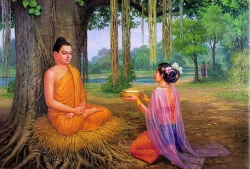The Feminine Spirit in Buddhism
by June Bianchi
While the structure and hierarchy within Buddhism is patriarchal (although being non-theistic it does not have a presiding masculine deity), various traditions of Buddhism have within their cosmology inspirational beings and deities who are female. The feminine spirit is inherent in Buddhist scripture and iconography as well as in the practice of both male and female Buddhists in all traditions. The presence of the feminine spirit and its dissemination, often by women teachers of Buddhism, can be a radical and direct means of contacting the heart of Buddhist practice: the heart of wisdom and compassion.
I would like to first look at the historical feminine spirit as it manifests in two Buddhist deities, Tara and Kwan Yin, and then see how it impacts contemporary practice through two women teachers who are actively working with this energy
The remains of the matriarchal religion which preceded our steadily waning patriarchy can be found scattered across the globe, from the womb-like hill of Silbury to the Venus sculpture in France and the caves of Malta and Gozo. The spirit of the feminine endures in all religions from the Jewish Shekhinah, the Gnostic Sophia to the Tibetan Buddhist Tara; all three embodying the quality of wisdom. This 4th century Sutra glorifies the creative munificence of Tara ...
`For she the perfection of wisdom is their mother and begetter, she showed them all knowledge, she has begotten and shown that cognition of all knowing.
While embodying wisdom, Tara is widely venerated for her compassion, symbolised in the posture of the Green Tara who is poised on her Lotus blossom with leg outstretched in readiness to leap to the aid of here supplicant. John Blofeld describes this aspect in his book `The search for the goddess of Compassion' in various anecdotes and fables of the Tara's miraculous interventions on behalf of her, frequently roguish, devotees.
Both Tara and other female beings in Tibetan iconography such as the Dakinis, who can manifest wrathful as well as compassionate aspects, are simultaneously regarded as being inner manifestations of the Universal Void, aspects of consciousness and of energy, and as external beings of devotional focus.
The Chinese female deity, Kwan Yin, `She who hears the cries of the world', is closely akin to Tara, she offers devotees the heavenly Dew, the beneficent stream of living water. Kwan Yin forms a deep connection with the ancient matriarchal figures presiding over creation, the earth, fertility and birth; she guards the souls of the new born and venerated in folk mythology of her miraculous intervention and the mystical metaphor of her being. Blofeld's desctiption of a devout nun's meditations on Kwan Yin (p.124) is a marvellous exposition of the transformation of form to emptiness and a tribute to the luminosity.
An anomaly exists between the respect accorded the feminine within Buddhist cosmology and the limitations imposed on women's role within the religious orthodoxy and structure. The misogynist views attributed to the Buddha in the Pali Canon and numerous other expressions of solidarity and support which he gave to his female followers. A strong argument has been made for an overlay of social construction being imposed on the teachings in their 400 years in oral form. The female Sangha certainly lapsed after the Buddha's death and in some traditions only partially reinstated. Despite these restrictions Buddhism has not been impervious to change and many traditions now have prominent women teachers. Others have male teachers who are willing to examine structures and practices in the light of both Eastern and Western paradigms of gender.
While the Theravadin nun Ayya Khema operates within a traditional context of Buddhist teaching and does not espouse the notion of a specifically feminine spirituality her work and teachings are a focus for many Buddhists within a male dominated tradition. Her conviction is that equal potential for realisation is present in both sexes and that each individual must find a balance within her or himself. The qualities of emotion and rationality need to be balanced and while Ayya Khema feels that women have a tendency towards the former and men to the latter, she concedes that this may be due to conditioning rather than innate. Ayya Khema's calm and kindly wisdom suggest that she has moved forwards considerably in her own process of balancing the two essential aspects of nature.
Tsultrim Allione, who has translated women practitioners of the Tibetan Buddhist traditions in her book `Women of Wisdom' is an active celebrant of the feminine spirit of Buddhism. she regards the patriarchal structure as under-pinning the schisms which characterise our era: between the sexes, between sexuality and spirituality, between dark and light, between earth and spirit Tsultrim Allione advocates integration of matter and spirit and she evokes the energy of the Dakinis in her teaching and practice.
Whether we are male or female Buddhists we can hold within us the spirit of the other; in Jungian psychological terms the Anirnus or Anima. the masculine spirit of Buddhism can find balance in the presence of the feminine in both historical and contemporary aspects.
Copy from Indra's Network, Journal of the UK Network of Engaged Buddhist.

